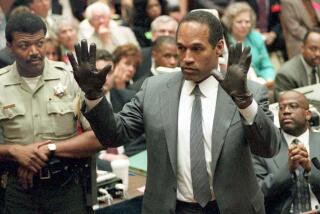After 50 Years, Few Reminders of Lindbergh Case : Town Forgets Trial That Put It on Map
- Share via
FLEMINGTON, N.J. — A service station charged a whopping $2 a day for parking, churches served meals to the hundreds who flocked to this tiny borough and two boys who sold the “Hauptmannville News” for 2 cents were flooded with requests for copies from around the country.
It was January, 1935, and Bruno Richard Hauptmann was on trial in an 18th-Century courthouse for the kidnaping and murder of Charles A. Lindbergh Jr., infant son of the famed aviator.
A half-century later, there’s hardly a trace of the sensational trial in this small town, except for some yellowed scrapbooks and older residents’ memories of the tacky souvenirs sold during the proceeding to persons who had paid up to $25 for a courtroom pass.
The trial began 50 years ago and, after six weeks of testimony and mostly circumstantial evidence, the jury returned a verdict: guilty. On April 4, 1936, the German immigrant, who professed his innocence to the end, went to the electric chair at Trenton State Prison, capping one of the most notorious criminal cases in American history--but not burying it.
Only last August, a federal judge in Newark dismissed a wrongful death suit brought by Anna Hauptmann, the condemned man’s widow.
Today, this Hunterdon County borough of 4,130 residents is known mostly for its hundreds of manufacturers’ outlets, which draw crowds of bargain hunters. There are no remnants of the trial. No official commemoration is planned.
“If you went around town, I don’t believe one person in 100 would remember, or be of the age to remember,” said C. Ryman Herr Jr., an attorney whose father practiced law with Lloyd Fisher, a member of the defense team.
Herr is among the few residents who recall how 400 news photographers, reporters and newsreel producers--more than the number who covered World War I--briefly turned Flemington into the most watched spot in the world.
Boys Wrote News Sheet
The lawyer said that, as an enterprising 8-year-old, he and a pal started the “Hauptmannville News,” writing news and gossip of the trial in pencil on their parents’ stationery.
Herr said that the news sheet was purchased mostly by kind neighbors until the now-defunct New York Sun published a story on the young newsmen. Soon, he said, they received a “flood of orders” and earned about $30.
“It was nice to have some excitement,” Herr said. “I just remember adults talking, churches and granges and homeowners taking in people and feeding people.”
The unofficial local keeper of Lindbergh memorabilia is Thelma Miller of Three Bridges, who skipped classes as a high school senior to attend the trial.
Miller said that her father, an undersheriff who guarded Hauptmann, was able to obtain much-sought-after daily trial passes, and her brother sold his for $25.
“It was a circus,” said Miller, a retired school secretary who has 10 scrapbooks filled with newspaper clippings on the Lindberghs and the crime from the 1930s to the present, numerous photographs and other mementos.
She said that hawkers sold $1 miniature wooden ladders supposed to resemble the one authorities believed the kidnaper used to take the infant from his crib in a second-floor nursery at the Lindberghs’ East Amwell Township estate.
Also in her collection are envelopes sent to the postmaster, decorated with pictures of ladders and addressed to such places as “Bruno, N.J.,” and “Hauptmannville, World News Center (Flemington, N.J.).”
Miller said she hopes that her collection will end up with the local historical society, which has no artifacts because the overseer at the time of the trial was disgusted by the whole affair.
More to Read
Sign up for Essential California
The most important California stories and recommendations in your inbox every morning.
You may occasionally receive promotional content from the Los Angeles Times.









